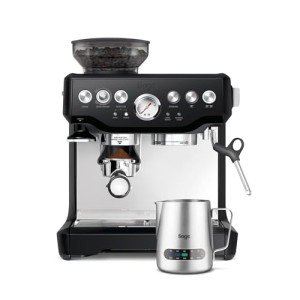The Ultimate Guide to Whole Bean Coffee Machines
In an age where coffee enthusiasts have ended up being progressively discerning, the choice of a coffee machine has actually ended up being more critical than ever. Best Bean To Cup Coffee Machines have become a preferred among major coffee drinkers, enabling them to extract the freshest tastes from coffee beans. This short article digs into the complexities of whole bean coffee machines, exploring their functions, advantages, and considerations for the devoted coffee fan.
What is a Whole Bean Coffee Machine?
A whole bean coffee machine is created to grind coffee beans simply before developing, guaranteeing optimum freshness and taste extraction. Unlike standard coffee machine that depend on pre-ground coffee, these machines integrate a grinder, which enables the user to pick the grind size fit to their developing technique, from espresso to French press.
Advantages of Whole Bean Coffee Machines
- Freshness: The primary benefit of using whole beans is that they retain their flavor longer than pre-ground coffee. Grinding right before brewing protects the fragrant oils that add to the total flavor profile.
- Personalization: Many whole bean machines allow users to adjust grind settings, water temperature level, and brewing time to create a customized cup of coffee that meets private choices.
- Quality Control: Whole bean coffee machines empower users to choose high-quality beans from numerous sources, making it simpler to check out distinct taste profiles.
- Versatility: These machines cater to various brewing techniques, making it possible for users to craft espresso, drip coffee, or specialty brews with ease.
- Convenience: Integrated mills streamline the coffee-making procedure, reducing the requirement for additional equipment and decreasing clean-up.
Secret Features to Consider
When picking a whole bean coffee machine, several features should be considered:
Grinder Type:
- Burr vs. Blade: Burr grinders provide a more uniform grind, which is vital for consistency in taste, whereas blade grinders tend to produce unequal grinds.
- Brew Method Compatibility: Ensure the machine can accommodate the developing technique chosen (e.g., espresso, pour-over, French press).
- Capability: Consider the hopper size for holding coffee beans; bigger capabilities indicate less frequent refilling.
- User Interface: Look for machines with user-friendly controls, enabling users of all skill levels to operate them quickly.
- Upkeep: Machines that are simple to tidy and preserve will save time and make sure the durability of the device.
- Product Quality: Stainless steel and top-quality plastic deal toughness, while machines with glass parts tend to be less long lasting.
Popular Whole Bean Coffee Machines
| Brand | Design | Mill Type | Capability (Cups) | Features | Cost Range (₤) |
|---|---|---|---|---|---|
| Breville | BES870XL Barista Express | Burr | 8 | Espresso machine, steam wand | 600 - 700 |
| De'Longhi | EC702 | Pump | 10 | Double boiler system, stainless steel | 300 - 400 |
| Cuisinart | DCC-3200P1 | Blade | 14 | 24-hour programmable, drip coffee | 50 - 100 |
| Rancilio | Silvia | Burr | 2 | Expert feel, steam power | 700 - 800 |
| Hamilton Beach | 49980A | Mixed | 2 | Single-serve, versatile developing | 30 - 50 |
How to Make the Most Out of Your Whole Bean Coffee Machine
To achieve the best results with a whole bean coffee machine, consider the following pointers:
- Quality Beans: Always choose high-quality, fresh beans that suit your taste.
- Grind Size: Adjust the grind size based on the brewing technique. Finer grinds are proper for espresso, while coarser grinds work much better for French press.
- Developing Temperature: Water temperature level ought to usually be in between 195 ° F and 205 ° F (90 ° C -96 ° C) for optimal extraction.
- Water Quality: Use filtered water for the best taste and to extend the machine's lifespan.
- Maintenance Schedule: Regularly tidy the grinder and machine to prevent residue accumulation and ensure consistent efficiency.
FAQs about Whole Bean Coffee Machines
1. Is a whole bean coffee machine worth the investment?
Yes, if you value the freshness and taste of your coffee, buying a whole bean coffee machine is advantageous. It enables a richer and more fragrant cup of coffee compared to pre-ground choices.
2. How do I clean my whole bean coffee machine?
Most machines include cleansing guidelines. Generally, you'll require to eliminate the grinder, clean the hopper, and run a cleansing cycle with water. Usage brushes particularly designed for this function.
3. Can I utilize pre-ground coffee in a whole bean machine?
The majority of whole bean coffee machines are particularly developed for whole beans; nevertheless, some might allow you to use pre-ground coffee. Seek advice from the maker's guidelines.
4. What is the best grind size for espresso?
A fine grind is typically chosen for espresso. However, experimentation can assist discover the ideal grind size that matches your taste choices.
5. How often should I replace the coffee beans?
For optimal freshness, it is motivated to use coffee beans within two weeks of opening after they have actually been roasted. Store them in an airtight container away from light and wetness.
A whole bean coffee machine can raise the coffee experience, offering freshness, personalization, and remarkable taste. With many options readily available, prospective purchasers can find a machine that fits their lifestyle and coffee choices. By considering the previously mentioned functions, ideas for optimization, and preserving a consistent cleaning regimen, users can enjoy every cup of freshly brewed, fragrant coffee for several years to come. Whether for personal use or amusing guests, purchasing a whole bean coffee machine is a step towards coffee perfection.

